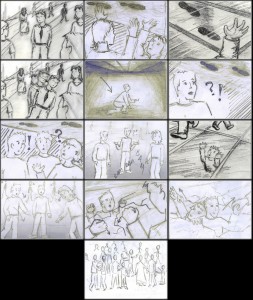Para leer este blog en español pincha aquí.
Just when we have made all the important decisions and it seems everything is sorted out and we can start thinking about the dates for the shooting day, all our decisions come tumbling down.
Technical problems (re)appear. We speak to the director of photography and he sheds some light on our doubts. At the same time, he shows us alternatives to problems we thought we had already solved.
We decide to have a meeting with him. It is the first meeting that brings together the CGI specialists, the director of photography and the production team.
There are some decisions we need to take up again. The storyboard is lying on the floor. It is the reference everything revolved around. The shooting schedule is also important. We have grouped all the shots we want to shoot. There are some shots in which we need the crowd walking over the glass, other in which we need to see the world above or below the glass. We should point out all the technical details for each group of shots.
We discuss how to get that over-exposed atmosphere for the wide shot, what kind of equipment, lights and studio we will need. There are different possibilities: shots below the glass in green screen. Shots of the crowd walking in a white infinity cove. There are different options…
A) Build a glass structure/perspex Vs. Shooting in a location with glass floor/ceiling.
B) Green Screen Vs White infinity cove.
All options are possible. Now, we need to make the right decision. We need to investigate a little bit more…
There are also different studios we could shoot in. The CGI people need to tell us if the spaces we have chosen are suitable for our shots, if it is possible to shoot there, and if the ceiling is tall enough for the shot we have chosen and the angles.
The director of photography tells us that there is a location that might be suitable for our plans because it has a glass floor/ceiling. He will send us some pictures tomorrow so we can get an idea about the aesthetic this location would create.
The conclusion: the easier thing for us to do would be to shoot in a location and in a studio with green screen, so that we do not need to build a structure.
The meeting is over. A million of different options is the result. Everybody has the feeling that there are more questions than answers. We are in a roller coaster going up the hill. We are waiting for the DoP and CGI technicians to decide which one is the best option. At which point the roller coaster will start speeding towards the finish…
If you want to get more information about the project “Speak out against discrimination”, click here.
For more information about Spectacle, click here.

